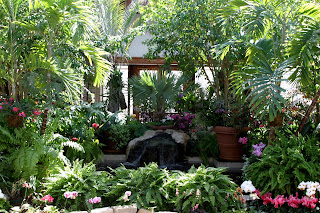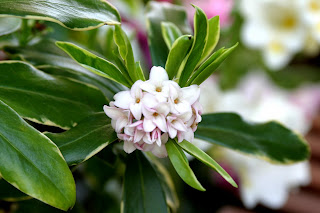Lyman Whitaker's kinetic wind sculptures were installed by the Leopold Gallery's Paul Dorrell Tuesday evening and are in place ready for their Powell Gardens public debut. They are a must see in motion by prairie winds in the heartland landscape of Powell Gardens. Here is the centerpiece in front of the Visitor Center, shown with the Heartland Harvest Garden "skyline" as backdrop.
The sculptures are located from the Visitor Center, along the Dogwood Walk to the Island Garden and will remain through Memorial Day weekend. All pieces are available for purchase at the Visitor Center's Perennial Gifts.


Staff (Marie Frye left and Shelly Bruellisauer right) are busy finishing planting the spring, frost tolerant and cool weather loving annuals. Most of the beds of spring season flowers should be planted by this Easter weekend.

Horticulturist Anne Wildeboor prunes the last of our roses -- it is time to prune your roses! This Hot Cocoa rose was cut back to where new leafy buds were emerging. Anne pruned the stems off at an angle just above a bud that was pointing outward so that new growth would not be crowded and bloom heavily by late spring.

Senior Gardener Mark Gawron was finishing tidying projects in the seating area ensconced in daffodils along the lower Dogwood Walk. The Island Garden's waterfall wall in the background was roaring in the wind and I wish I could add that sound and motion experience to this image.

Early Daffodils will be at peak later this week and drifts are in full bloom here at the entrance to the Perennial Garden.

The Fountain Garden is up and running again and may likely see its first participant in today's 80F weather!

The Heartland Harvest Garden already has many fresh greens ready for picking. The fresh shoots of chives are seen in this picture as companion plants to the apple trees of the Apple Celebration Court.

Please peek inside the movable backyard greenhouse in Barbara Damrosch's Authors' Garden. Many fresh greens including unique Miner's Lettuce (Montia perfoliata) can be observed. I am shocked by how much produce could already be sampled and am tempted to set up a makeshift tasting station so people can savor fresh chives, miner's lettuce, peppery winter cress, succulent Profusion French sorrel, incredibly floral sweet violet flowers and more!!! Tasting Stations should open in May but available produce will be part of Cafe Fresh's menu starting Saturday (April 3) weather permitting.

The new Learning Shed which anchors the Fun Food Farm is nearing completion. The Villandry beds in the foreground of this photo will be planted by this Easter weekend with frost tolerant, cool season edibles.

Don't forget to visit the top of the silo observation deck for a springtime view of the gardens!

100,000 daffodils will bloom this spring season and the early varieties like 'Ice Follies' are already open -- this variety opens with a yellow center cup in cool weather but will soon age to light cream, often fading to almost white in warm weather.

Hyacinths, like this cultivar 'Splendid Cornelia' are also in bloom and attracting hungry honeybees with their sweet aroma.

Our nationally significant collection of Magnolias are also poised for bloom in the next few weeks. Here the cultivar 'March 'til Frost' has swelling buds showing its burgundy colored flowers soon to be in full bloom.











































